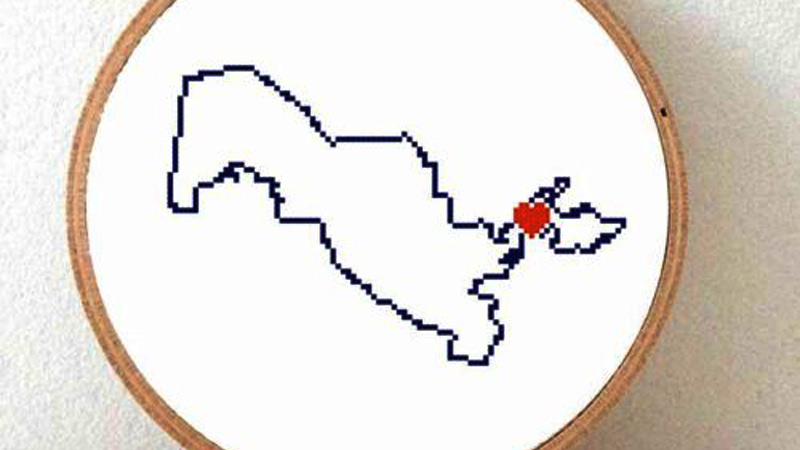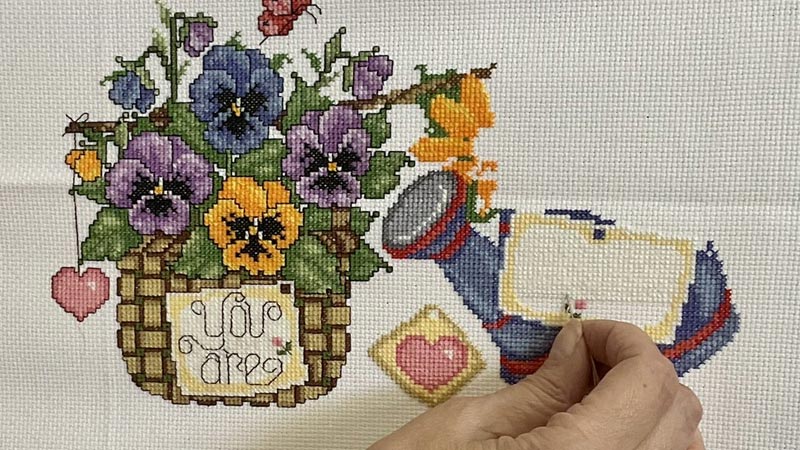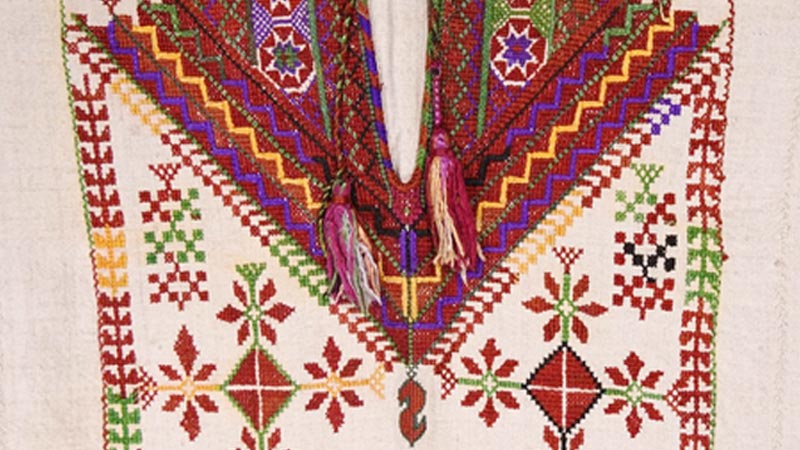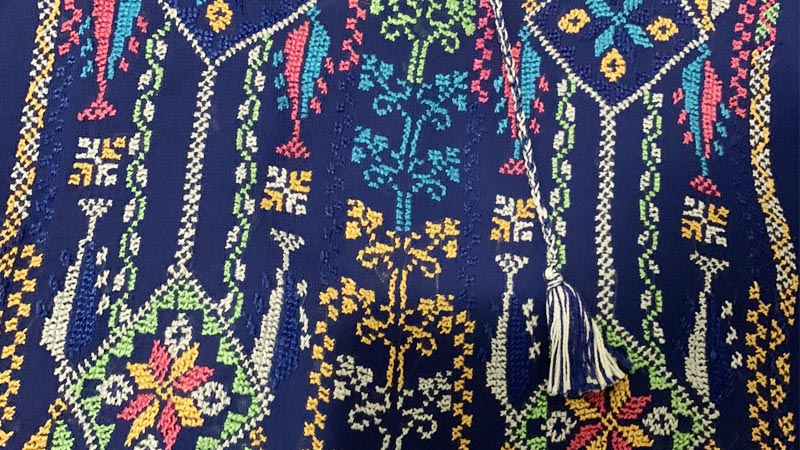The origins of cross stitch, a cherished form of embroidery, have long intrigued historians and needlework enthusiasts. While cross stitch has been documented in the Middle East as far back as the 9th century AD, its precise origin remains a subject of debate.
This intricate needlework technique has an enduring global presence, with diverse and captivating patterns gracing textiles from various corners of the world.
In this exploration, we delve into the rich tapestry of cross stitch, considering its potential roots in the Middle East and its evolution as a global craft.
While historical evidence connects it to the Middle East, crossstitch has transcended geographical boundaries to become a symbol of artistic expression, cultural identity, and shared heritage.

Is Cross Stitch Originated In the Middle East?
The precise origin of cross stitch remains a topic of historical debate, and it is not definitively believed to have originated solely in the Middle East. Cross stitch, a form of embroidery characterized by X-shaped stitches on fabric, has been practiced for centuries worldwide.
While evidence suggests its presence in the Middle East and its documentation by Arab traders in the 9th century AD, similar needlework techniques likely developed independently in different cultures.
Cross stitch, over time, spread through trade, cultural exchange, and conquest, becoming a popular and enduring craft enjoyed by people globally. Its history is a testament to its adaptability and appeal, with diverse contributions from various regions.
What Is the History of Cross Stitch in the Middle East?

The history of cross stitch in the Middle East is a rich tapestry that reflects the region’s longstanding tradition of intricate and skilled needlework. While the exact origins remain somewhat elusive, historical evidence suggests that cross stitch has been practiced in the Middle East for centuries.
Here is an overview of the history of crossstitch in this region:
Early Documentation
Crossstitch in the Middle East was first documented by Arab traders during the 9th century AD. These traders and travelers recorded the use of cross-stitch-like techniques in textiles, offering valuable insights into the practice at the time.
Intricate Patterns
Crossstitch in the Middle East is characterized by the use of geometric and floral patterns. These designs often exhibit a high level of intricacy, with a focus on symmetry and precision. Cross stitch was frequently employed to adorn clothing, household items, and decorative textiles.
Cultural Significance
Cross stitch held cultural and artistic significance in the Middle East, with patterns and motifs often reflecting the region’s unique aesthetics and cultural heritage. The craft was a means of personal expression and a way to connect with traditional designs.
Continuity and Tradition
Crossstitch has continued to be a cherished and enduring craft in the Middle East. While modernization has introduced new techniques and designs, the traditional art of cross-stitching remains an essential part of the region’s cultural fabric.
Contemporary Resurgence
In recent years, there has been a renewed interest in traditional crafts, including cross-stitch, in the Middle East. Artisans and crafters are blending the old with the new, creating contemporary designs that pay homage to the rich history of crossstitch in the region.
What Are Some Famous Examples of Cross Stitch From the Middle East?

Cross stitch, an ancient and intricate form of embroidery, has a long and celebrated history in the Middle East. While specific famous examples of cross-stitch pieces may not be widely documented, the region is renowned for its rich and diverse cross-stitch traditions.
Here are some general categories of famous examples:
Traditional Palestinian Thobes
Palestinian dresses, known as “thobes” or “thawbs,” are renowned for their stunning cross-stitch embroidery. These dresses are an iconic representation of Palestinian culture, with each region featuring its unique style and patterns.
Vibrant and intricate cross-stitch designs adorn the garments, often reflecting the wearer’s regional and familial heritage.
Tunisian Cross Stitch
North Africa, including Tunisia, boasts a rich cross-stitch embroidery tradition. Traditional Tunisian clothing and textiles are adorned with geometric patterns and motifs created through cross stitch. The craftsmanship and artistry of Tunisian crossstitch are highly regarded.
Egyptian Embroidery
In Egypt, cross stitch has been used to enhance both clothing and home textiles. Egyptian crossstitch often showcases floral and geometric designs, which are integral to the country’s textile heritage.
Lebanese Cross Stitch
Lebanon has its own distinct cross-stitch tradition. Cross-stitch patterns in Lebanese embroidery are frequently seen on dresses, tablecloths, and pillow covers. The designs often feature stylized flowers and geometric shapes, reflecting the country’s rich heritage.
Syrian and Jordanian Cross Stitch
The cross stitch embroidery of Syria and Jordan is celebrated for its intricate geometric patterns and vibrant color combinations. These designs are commonly found on clothing, pillowcases, and other textiles, showcasing the craftsmanship and artistic expression of the region.
Yemeni Cross Stitch
Yemen boasts a unique cross-stitch tradition with patterns that often vary by region and tribal influences. This intricate form of embroidery is used to adorn traditional clothing, making it an essential aspect of Yemeni cultural identity.
What is the Historical Significance of Cross Stitch in the Middle East?

The historical significance of cross stitch in the Middle East is profound and multifaceted, reflecting the rich cultural tapestry of the region. Cross-stitch embroidery has played a vital role throughout the history of the Middle East for numerous reasons:
Cultural Heritage
Cross-stitch embroidery is deeply ingrained in the cultural heritage of the Middle East. The craft has been passed down through generations, and patterns often carry symbolic significance, representing elements of nature, religious beliefs, or regional identity.
Traditional Attire
Cross stitch has been an integral part of traditional Middle Eastern clothing. Thobes, dresses, and other garments are often adorned with intricate cross-stitch designs, not only for aesthetic appeal but also as a means of expressing one’s cultural and regional affiliation.
Community and Social Bonds
The art of cross-stitching has historically provided a platform for social interaction and community bonding. Women, in particular, have come together to engage in cross stitch, sharing stories, traditions, and knowledge while crafting.
Artistic Expression
Skilled artisans in the Middle East have used cross stitch as a medium for artistic expression. The craft requires precision and creativity, resulting in a wide array of intricate and visually captivating designs.
Historical Significance
Cross-stitch patterns often incorporate historical elements, and they can serve as a visual record of significant events or cultural developments in the Middle East.
Decorative Arts
Cross stitch has been applied to a variety of household textiles, including pillowcases, tablecloths, and curtains. These items not only serve a functional purpose but also carry cultural and aesthetic value.
Economic Value
In addition to its cultural significance, crossstitch has also had economic value in the Middle East. Artisans and crafters have created pieces for sale and trade, contributing to regional economic activity.
Continuity and Tradition
Cross stitch is a time-honored craft that has been carefully preserved and passed down through generations. Its enduring presence ensures the continuity of cultural traditions.
Modern Resurgence
In recent years, there has been a resurgence of interest in traditional crafts, including cross-stitch, in the Middle East. Modern artisans are blending traditional techniques with contemporary designs, keeping the craft alive and relevant.
Heritage Preservation
Cross stitch plays a critical role in preserving Middle Eastern heritage. Its historical significance and cultural relevance underscore the importance of safeguarding and celebrating these traditions for future generations.
FAQs
What is the Origin of Cross Stitch?
The origin of the cross stitch is unclear, but it’s an ancient and global embroidery technique with evidence of early use in regions like the Middle East.
Is Cross Stitch an Ancient Craft?
Yes, cross stitch has been practiced for centuries, with documented evidence of its presence in the Middle East as far back as the 9th century AD.
How Has Cross Stitch Evolved Over Time?
Crossstitch has evolved through cultural exchanges, modern influences, and contemporary designs, adapting from traditional to diverse and versatile needlework.
What is the significance of cross-stitching in different cultures?
Cross stitch holds cultural, artistic, and historical significance worldwide, reflecting unique traditions, symbols, and heritage, uniting people through creativity and storytelling.
Is Cross Stitch a Worldwide Craft?
Yes, crossstitch is enjoyed by people worldwide, and its adaptability has allowed it to transcend geographical boundaries.
To Recap
The history of cross stitch is a testament to its enduring appeal and adaptability. While the Middle East has contributed significantly to its rich tapestry, it is evident that cross stitch, with its intricate beauty, has evolved independently in various cultures.
Its roots may be traced to the Middle East, but its branches have extended far and wide, becoming a beloved art form worldwide.
Cross stitch embodies the essence of cultural exchange and artistic expression, serving as a bridge connecting diverse traditions.
Its historical significance, from the documented accounts by Arab traders to its presence in contemporary craft, highlights the enduring charm of cross stitch, an art form that transcends borders and continues to weave stories through every careful stitch.
Leave a Reply